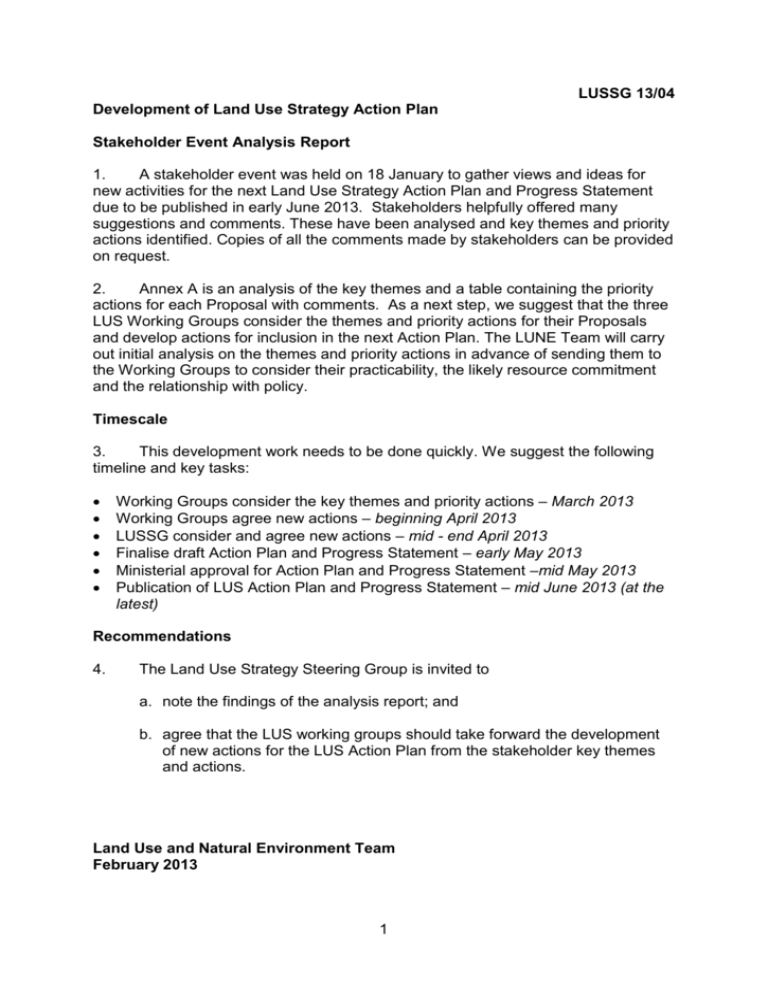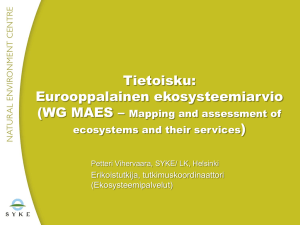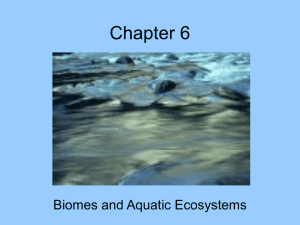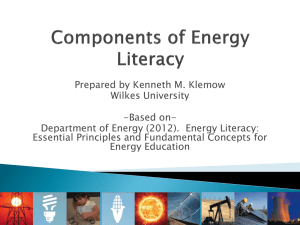Open - The Scottish Government
advertisement

LUSSG 13/04 Development of Land Use Strategy Action Plan Stakeholder Event Analysis Report 1. A stakeholder event was held on 18 January to gather views and ideas for new activities for the next Land Use Strategy Action Plan and Progress Statement due to be published in early June 2013. Stakeholders helpfully offered many suggestions and comments. These have been analysed and key themes and priority actions identified. Copies of all the comments made by stakeholders can be provided on request. 2. Annex A is an analysis of the key themes and a table containing the priority actions for each Proposal with comments. As a next step, we suggest that the three LUS Working Groups consider the themes and priority actions for their Proposals and develop actions for inclusion in the next Action Plan. The LUNE Team will carry out initial analysis on the themes and priority actions in advance of sending them to the Working Groups to consider their practicability, the likely resource commitment and the relationship with policy. Timescale 3. This development work needs to be done quickly. We suggest the following timeline and key tasks: Working Groups consider the key themes and priority actions – March 2013 Working Groups agree new actions – beginning April 2013 LUSSG consider and agree new actions – mid - end April 2013 Finalise draft Action Plan and Progress Statement – early May 2013 Ministerial approval for Action Plan and Progress Statement –mid May 2013 Publication of LUS Action Plan and Progress Statement – mid June 2013 (at the latest) Recommendations 4. The Land Use Strategy Steering Group is invited to a. note the findings of the analysis report; and b. agree that the LUS working groups should take forward the development of new actions for the LUS Action Plan from the stakeholder key themes and actions. Land Use and Natural Environment Team February 2013 1 Annex A Land Use Strategy Action Plan Workshop 18 January 2013 Analysis 1. Introduction 1.1. This report provides an analysis of the Land Use Strategy LUS stakeholder workshop held at Scottish Government, Victoria Quay on 18 January 2013. Stakeholders provided a large number of suggestions for new actions for each LUS Proposal. The information was collated and synthesied and main themes identified. There were a significant number of cross cutting themes and these are detailed below. Section 2 below provides the main themes for the whole workshop across all the Proposals, Section 3 cross cutting themes, Section 4 important additional suggestions not picked up in the cross cutting themes and Section 5 the original actions suggested by stakeholders with our initial comments. Section 5 actions have not been altered except where there was duplication. 1.2. Reading across all suggestions, it was clear that many stakeholders appeared to be unaware of where to go to find information about land use, were unaware of what was on SEWeb and many had not read the previous Progress Statement. This meant that some suggestions were for actions that Scottish Government and SEARS had already intiated. It was felt that actions were still government heavy and that the LUS will only secure buy in if all stakeholders are involved. It was suggested that SNH should publicise others who can help. 2. Workshop main themes 2.1. Stakeholder suggestions were collated and synthesised. A number of themes emerged from the analysis as follows: Best practice integrated land management demonstration projects to show environmental valuation including carbon and ecosystems services, applying an ecosystems approach, peatland management, climate change mitigation and adaptation and handling land use conflicts. Information resources to support decision making including GIS and mapping of ecosystems services, user friendly mapping tool for land capability, audience targetted guidance documents for the ecosystems approach, environmental valuation, best practice land management, guidance on land use issues for communities. Also GIS "opportunity maps" to identify potential for multiple benefits and to determine suitability for SRDP funding. Use innovative and targetted communication methods to diseminate existing information. Language needs to be simple. 2 Peatland management and environmental markets. Raise awareness of peatland management, development of carbon accounting methods and environmental markets and payments for peatland management. Promoting an ecosystems approach through demonstration projects and targetted guidance. Build community capacity and resilience though guidance and direct support. Land ownership and the Community Empowerment Bill were felt to be important factors. Land manager advisory service and support for best practice land mangement including demonstration farms. 3. Cross cutting themes Demonstration projects/sites Across nearly all Proposals, participants suggested that practical projects were needed to show best practice land management of ecosystems services, practical application of peatland management, integration with SRDP, and delivery of climate change adaptation and mitigation objectives. Stakeholders suggested that an active network of demonstration sites and pilots was needed. Only a few particpants mentioned research and the necessity of a good evidence base to back up the practical projects. Carbon Markets and ecosystems services and peatlands Carbon markets and ecosystems services activities were mentioned frequently under Objective 1 and 2 Proposals. It was suggested that land managers need support to provide a range of ecosystem services and an environmental valuation mechanism which can deal with trade-offs and enhance the economy. Environmental markets, regulations and incentives should incorporate mechanisms for peatland management and valuation. There was a particular emphasis on establishing carbon accounting, including peatlands for land managers. Stakeholders felt that carbon accounting and grant funding should be linked and that incentives to persuade farmers and other land managers to consider a broad range of ecosystems serivces were needed. Peatland management featured in Objectives 1 and 2 Proposals. Participants were concerned about carbon accounting, environmental valuation and payments for the trade-offs that land managers may have to make. Information resources to support decision making Many participants appeared to be unaware of existing activities and publications and suggested that better promotion was needed. In addition, many participants suggested that better use of existing information was important as was developing information resources which supported decision-making such as GIS opportunity mapping for ecosystems services. Need to publicise the land use hub more widely and link Scottish Government LUS website with other websites. 3 Support for land use decision making was considered to be important with stakeholders suggesting a range of advice and tools including an advisory service for land managers,(whole farm plans were highlighted), information resources to support land managers and enable them to understand and comply with regulations and incentives, practical guidance on integrated land management and ecosystems services and practical support for land based businesses to reduce GHG emission and enable adaption to climate change. Climate change Stakeholders focussed on the practical aspects of climate change mitigation and adaptation measures for land use and wanted to see practical projects which demonstrated these. Data/GIS This was mentioned under Objective 2 and 3 Proposals. Stakeholders felt that useable GIS data and national maps needed to made be available as well as national level analysis of land use change impacts. It was suggested that SEWeb should expand its GIS accessible environmental data. In addition an accessible user friendly website to show what land managers are doing on the ground to deliver ecosystems services was called for. Incentives, regulations, LUS and CAP Particpants felt that the CAP and SRDP needed to be aligned with the LUS and that land managers needed support. An advisory service was suggested to help land managers deal with the range of incentives and regulations including SRDP. Practical guidance and demonstration projects should also cover incentives and regulations. There was, however, concern that SEARS would not have the capacity to deal with CAP/SRDP applications etc. More emphasis needed on helping farmers/land managers understand regulatory requirements and what policy is trying to achieve through advice, events etc. The monitor farm approach and whole farm plans were suggested as good mechanisms for delivery of LUS Proposals. 4. Important additional suggstions This section provides additional suggestions for each of the LUS objectives not covered by the the main themes or cross-cutting themes. Objective 1 - Proposals 3,4, 5, 6 and 7 Common Agricultural Policy CAP/incentive/regulations Proposal 3 and 5 are related and the priorities for Proposal 5 depend on the next CAP. Information, advice, and tools Stakeholders suggested a range of advice and tools including an advisory service for land managers (whole farm plans were highlighted), a spatial mapping tool for land use planning and management and opportunity mapping to identify the best places for trees. Making better use of the information from Farming for a Better Climate and Focus Farms was suggested as well as utilising the Quality Meat Scotland Monitor Farms. 4 Climate change and land management demonstration projects Stakeholders called for initiatives to encourage innovation in land management to contribute to climate change objectives including energy efficient planning for land managers. Particular suggestions included - quantify carbon footprint of agricultural products & link to marketing e.g. award status like organic to influence consumer buying patterns. It was suggested that CAP Pillar 1 & Pillar 2 should encourage GHG emission reduction and adaptation to climate change. There was also concern about farm woodlands and the valuation of ecosystems services. Monitor farms were highlighted as exemplars. Identify existing exemplar projects and areas of research for climate change adaptation. Crofting Demonstrate the benefits of linking crofter’s duty to use crofts to deliver wider land use objectives and demonstrate that regulation of residency duty for crofters is a powerful strategic tool. Integrated spatial land use planning It was suggested that regional integrated spatial land use plans, facilitated and supported by public and third sector was needed. Whole farm plans were mentioned in this context. Scottish Association of Farm Conservation Advisors. The Scottish Association of Farm Conservation Advisors may be a way for farmers to provide their views on CAP/SRDP etc. Champions Stakeholders suggested that ‘champions’ of best practice are needed - to act as leaders in communities and to nurture the LUS/ecosystem approach at both the regional scale (catchment) and within farming communities. Objective 2 - Proposals 8, 9 and 10 Demonstration Sites/Practical Examples Policy and research was needed to support demonstration sites and promote them. In addition, it was felt that ecological scale strategies were needed for land management. Communications More guidance and information on the practical aspects of applying an ecosystems approach including up to date, easily available data and practical guidance with clearer language was called for. Persuasive communication needed to raise awareness of peatlands. Stakeholders provided examples of alternative alternative means of communciation such as the RSA animation project. Peatlands and carbon accounting A strategic national-scale approach and transparent method for soil carbon accounting and a carbon sequestration accreditation scheme to allow for equal application across the country was called for. 5 6 Objective 3 - Proposals 11, 12 and 13 Education and training This theme cuts across Proposals 11 and 12 actions to promote better understanding of land use/climate change in education. Suggestions included the development of a school-based programme, outdoor learning, using the Scottish Outdoor Access Code and engaging children at primary and secondary level. Practical training, support, community capacity building assistance and training to support low capacity groups/communities to help them with climate change adaptation. Community empowerment Stakeholders suggested that community engagement models and mechanisms were needed for real engagement with local communities. It was also suggested that the LUS should integrate with the Community Empowerment Bill. Communities Web accessible FAQs and video were suggested so that communities may learn from others, maybe with contact information for dialogue/advice to enable communities to get involved in local debates. Information/communication technology was suggested as means of staging community debates and enabling decision making e.g. critical forums. There was a suggestion that strategic planning by communities as core of "community planning" should be rolled out. There were also suggestions for partnership working with agencies such as Development Trusts Association Scotland to assist communities in understanding how they can contribute. Finally there was felt to be a lack of communication between farmers/landowners and the public/ communities. Housing and demographic change Need to consider the impact of housing and demographic change on land use. This cuts across Proposals 11 and 12. Additional Proposals It was suggested that new Proposals covering the following were needed. o 1) access o 2) engaging communities in thinking about landscape change o 3) education and awareness raising o 4) land reform Land ownership Make critical links to land reform as ownership determines action on land use 7 5. Priority Actions (identified by stakeholders at the workshop) Proposal 3 Priority Action Comments Consideration of LUS Objectives and Principles is already an active part of CAP reform and SRDP development 4 Stakeholder groups should be opened up to wider elements in society Needs consideration Make sure NPF3 and planning policy deliver LUS objectives Work on the NPF3 and revised SPP have already given full consideration to the LUS Needs consideration alongside existing schemes such as Wildlife Estates Scotland 5 6 There is a need to ‘proof’ future policies in line with the LUS objectives eg SRDP, NPF3 All decisions about CAP reform should be ‘proofed’ against the LUS Introduce a recognition or award scheme to influence change eg an accreditation scheme Use "recognition" as a tool to influence change e.g. award scheme, accredited assurance scheme Some kind of award for land managers who are 'doing good things' Diversity is the key to adaptation. We need multifunctional land use Diversity is the key to adaptability e.g. no monoculture moorland or single-species management Needs consideration All decisions about CAP reform should be ‘proofed’ against the LUS See Proposal 3 There needs to be a more tangible link between CAP, the environment and climate change issues eg include payments for soil management. Payment for delivery of public goods See Propsal 3 and Proposal 9 Priorities for next SRDP - national and regional must reflect LUS objectives See Proposal 3 LUS pilots were announced on 6 Feb. Develop integrated land use pilots aimed at multiple benefits. Make sure they are not just about climate change Develop integrated pilots e.g. S.Uist. Define "effectiveness" to promote a strategic approach between sectoral interests 8 7 8 There needs to be more about adaptation. The current focus is on mitigation eg there should be more action on flood management or peatland management More demonstration projects/research/initiatives on climate adaptation (current activity focused on mitigation) e.g. flood peatland management There should be farm plans which set out woodland expansion plans aimed at achieving multiple benefits. These need free advice as part of their preparation Bespoke farm plans for woodland expansion that identified multiple benefits potential & funding mechanisms delivery. Needs facilitators & support. Needs consideration alongside on-going work on natural flood management and peatlands Needs consideration alongside all the actions which call for demonstration sites Needs consideration alongside the action plan developed as a result of the WEAG report Agro-forestry should be better integrated into agriculture. Develop agroforestry demonstration projects. The regulations need to promote agroforestry and recognise the benefits eg fuel, biodiversity, shelterbelts Needs consideration alongside all the actions which call for demonstration sites and in conjunction with developing SRDP proposals Needs consideration alongside all actions which call for guidance and information. Next steps could include promote existing ecosystems approach information note more widely. provide additional ecosystems approach guidance notes covering and local authorities, SEA, and other audiences as suggested below. consider different formats for information notes Needs consideration alongside all actions which call for guidance and information. Examples for people to follow One high level (umbrella) document with tailored guidance documents for specific audiences Distil existing information and synthesize good practice ( identify gaps, lessons learned , relevance) Practical guidance must (a) identify the desired outcomes (b) provide a mechanism for showing Local Authority policies ( etc.) do/do not "comply" with an ecosystems approach - the ultimate question is what would be different from business as usual and how do we know? * 9 Needs consideration alongside all actions which call for guidance and information. High level guidance on what we need to do to adopt Strategic Environmental Assessment SEA into ecosystems approach supported by information notes explaining more specific elements link between SEA and ecosystem approach. Use this to simplify SEA. Need for rationalisation. Needs consideration alongside all actions which call for guidance and information. Develop and communicate alternative scenarios of change in ecosystems services for desired management strategies Needs consideration alongside all actions which call for guidance and information. Publically funded data available free/open source Ecosystems services data and national datasets on peatlands, etc may be available already but may be diffficult for stakeholders to find or access. This action needs exploration. Perhaps SEWeb may provide some of this data and also the Scottish Government Strategic Research proivders. Consider with the other actions on data gathering across all the Proposals. Needs consideration. Identify existing outreach programmes which cover the ecosystems approach. Organise collaborative gathering of data and evidence for dissemination Outreach programme to develop a community of practice and ensure complete coverage of Scottish environment 9 Utilise the ability of local partnerships to deliver action Needs consideration Exploration of possibilities of place-based policy making in one area ( why - because sectorally based policy-making may actually prevent implementation of ecosystems approach by public bodies) Needs consideration alongside all the actions which call for demonstration sites. Get on and try it at a number of scales geographically. Identify aims and evaluate. Needs consideration alongside all the actions which call for demonstration sites. Simple clear communication, use of culture, art and poetry to communicate complexity and change hearts and minds.(including land managers) E.g Royal Highland show Needs consideration. The SNH 2020 Vision project provides an example of culture used to communicate biodiversity etc. Need regulations/incentives to deliver long term management. Policy/guidance needs to be integrated into incentives ( eg) SRDP or legally enforced. Eg make use of Carbon calculator. Obligatory when submitting planning application Needs consideration.Cuts across actions for Proposals 3 and 5. 10 Demonstration projects for community based projects 10 Use sites to demonstrate how existing policy conflicts have been resolved on site ( peat v forestry v renewables) Needs consideration alongside all the actions which call for demonstration sites. Needs consideration alongside all the actions which call for demonstration sites. Carbon accounting for land managers to then be used as a baseline for rewarding land managers and linked to carbon taxation, but don't tax land users only. Wider rollout through society Needs consideration. This is one of a group of actions on carbon accounting for land managers. Use SNH money to underpin establishment of robust mechanisms for peatland carbon code/valuation/markets Needs consideration. This is one of a group of actions on carbon accounting for land managers. Carbon grading system for land owners similar to a fridge or home ( A, B, C, D, etc.) Needs consideration. Need pilots at various scales. Has to be practical. Show good and bad examples Needs consideration alongside all the actions which call for demonstration sites. Needs consideration alongside all the actions which call for demonstration sites. Needs consideration. Crosscutting with Proposals 3 and 5. Establish active network of demonstration sites Incentives to persuade farmers to "farm" other ecosystems services rather than just agriculture. SRDP ( long term funding agreements spatially connected) to deliver - flood risk reduction, biodiversity, landscapes, energy, water How can we compensate "losers" in trade-offs? Public money vs private supply of ecosystems services Needs consideration. Monitoring of SRDP outcomes Needs consideration. Crosscutting with Proposals 3 and 5. Needs consideration. Related to Proposals 3 and 5. Proper monitoring and evaluation of environmental outcomes of the SRDP Invest in work required to establish environmental markets Identify policy priority eg reduce flooding and explore how to deliver it National level analysis of land use change on species. 11 Needs consideration. Related to Proposal 9 actions on carbon markets and environmental markets. Needs consideration. LUS provides national level policy. This action may be about local delivery of national priorities. Needs consideration. The SG Strategic Research Programme may provide evidence and analysis. Scenario modelling of changes in ecosystems processes resulting from changes in landscape management 11 12 13 Develop information about carbon footprint of different land uses and empower communities to press for reductions in these - thus adding resilience Needs consideration. The SG Strategic Research Programme may provide evidence and analysis. Needs consideration Integrate LUS with all relevant public policy areas and develop a hierarchy of how all the policies fit together - could be visual like a picture Needs consideration Practical training, support, community capacity building assistance Needs consideration Community Empowerment, developing models for different types of engagement by communities Needs consideration Mapping - interactive map of land use, ownership etc & allow for mapping survey data from citizen science Needs consideration. SE Web exploring the potential for the development of a Land Atlas, would solve issue of land ownership. Also SRDP data an issue. LUNE Team February 2013 12









